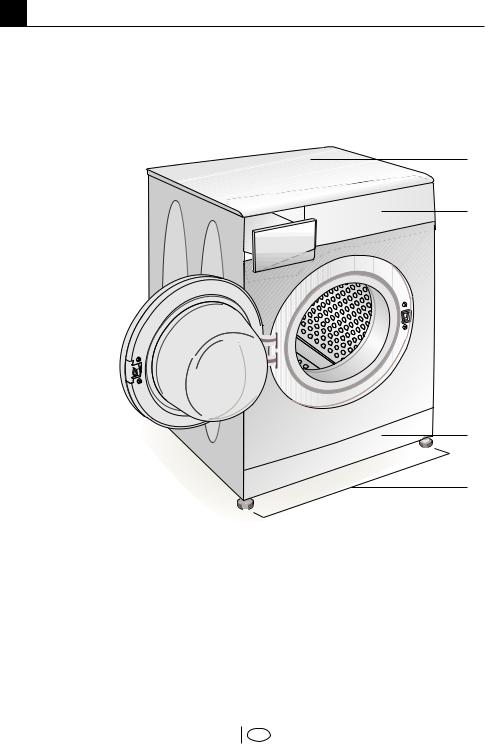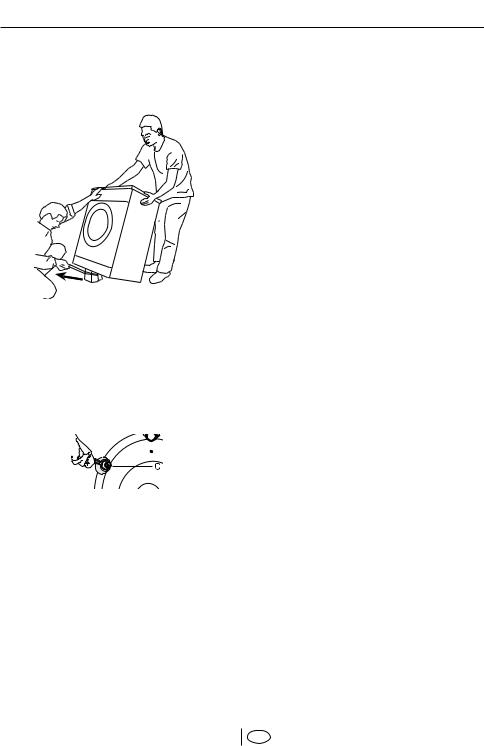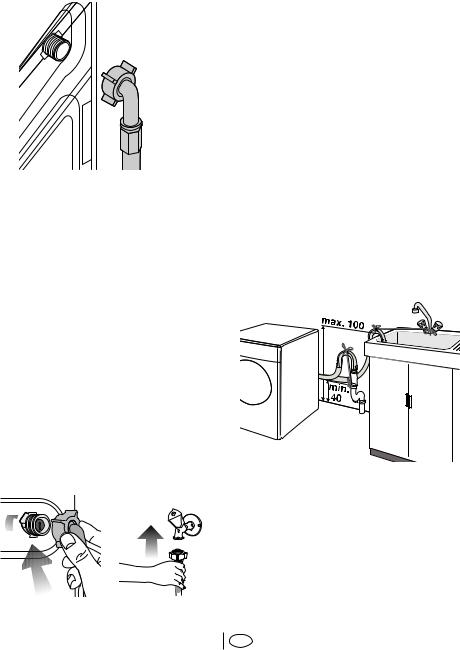Beko WMB 60831 DS, WMB 60831 D, WMB 61031 DS, WMB 61031 D User manual

Washing Machine
WMB 60831 DS WMB 60831 D WMB 61031 DS WMB 61031 D

Please read this manual first!
Dear Customer,
We hope that your product which has been manufactured in modern facilities and passed through a strict quality control procedure will give you the best results. Therefore, we advise you to read through this manual carefully before using your product and keep it for future reference.
This operation manual will…
…help you use your machine in a fast and safe way.
•Please read the Operation Manual before installing and starting your machine.
•Particularly follow the instructions related to safety.
•Keep this Operating Manual within easy reach. You may need it in the future.
•Please read all additional documents supplied with this machine.
Please note that this Operating Manual may be applicable for several other models.
Differences between models will be identified in the manual.
Explanation of symbols
Throughout this Operation Manual the following symbols are used:
C Important information or useful hints about usage.
AWarning for hazardous situations with regard to life and property.
BWarning for supply voltage.
<![endif]>2820521452_EN/311210.1020
This appliance’s packaging material is recyclable. Help recycle it and protect the environment by dropping it off in the municipal receptacles provided for this purpose.
Your appliance also contains a great amount of recyclable material. It is marked with this label to indicate the used appliances that should not be mixed with other waste. This way, the appliance recycling organised by your manufacturer will be done under the best possible conditions, in compliance with European Directive 2002/96/EC on Waste Electrical and Electronic Equipment. Contact your town hall or your retailer for the used appliance collection points closest to your home. We thank you doing your part to protect the environment.

TABLE OF CONTENTS
1 Your Washing Machine |
4 |
Overview . . . . . . . . . . . . . . . . . . . . . . . . 4
Specifications . . . . . . . . . . . . . . . . . . . . . 5
2 Warnings |
6 |
General Safety . . . . . . . . . . . . . . . . . . . . 6 First Use . . . . . . . . . . . . . . . . . . . . . . . . . 6 Intended use . . . . . . . . . . . . . . . . . . . . . 6 Safety instructions . . . . . . . . . . . . . . . . . 7 If there are children in your house... . . . . 7 Things to be done for energy saving . . . . 7
3 Installation |
8 |
Removing packaging reinforcement . . . . 8
Opening the transportation locks . . . . . . 8 Appropriate installation location . . . . . . . 8 Adjusting the feet . . . . . . . . . . . . . . . . . . 8 Connecting to the water supply. . . . . . . . 8 Connecting to the drain . . . . . . . . . . . . . 9 Electrical connection . . . . . . . . . . . . . . 10 Destroying the packaging material . . . . 10 Disposing of the old machine . . . . . . . . 10
4 Initial preparations for |
|
washing |
11 |
Sorting the laundry . . . . . . . . . . . . . . . . 11
Preparing clothes for washing. . . . . . . . 11 Correct load capacity . . . . . . . . . . . . . . 11 Loading door . . . . . . . . . . . . . . . . . . . . 12 Detergents and softeners . . . . . . . . . . . 12
5 Selecting a Program and |
|
Operating Your Machine |
14 |
Control Panel . . . . . . . . . . . . . . . . . . . . 14 Turning the machine on . . . . . . . . . . . . 15 Program selection. . . . . . . . . . . . . . . . . 15 Main programs . . . . . . . . . . . . . . . . . . 15 Additional programs . . . . . . . . . . . . . . 15 Special programs . . . . . . . . . . . . . . . . . 16 Spin Speed selection . . . . . . . . . . . . . . 16
Program selection and consumption table . . . . . . . . . . . . . . . . . . . . . . . . . . . 17
Auxiliary functions. . . . . . . . . . . . . . . . . 18 Time display . . . . . . . . . . . . . . . . . . . . . 19
Starting the Program . . . . . . . . . . . . . . 19 Progress of program. . . . . . . . . . . . . . . 19
Changing the selections after the program has started . . . . . . . . . . . . . . . . . . . . . . 20
Door lock . . . . . . . . . . . . . . . . . . . . . . . 20 Child-proof lock . . . . . . . . . . . . . . . . . . 20 Ending the program through canceling . 21 “Stand-By” mode . . . . . . . . . . . . . . . . . 21
6 |
Quick instructions for daily |
|
use |
22 |
|
|
|
|
7 |
Cleaning and care |
24 |
Detergent drawer . . . . . . . . . . . . . . . . . 24 The door and the drum. . . . . . . . . . . . . 24
Outer cabinet and control panel . . . . . . 24 Inlet water filters . . . . . . . . . . . . . . . . . . 24
Draining any remaining water and cleaning the pump filter . . . . . . . . . . . . . . . . . . . 25
8 Solution suggestions for |
|
problems |
27 |
3 EN

1
Your Washing Machine
Overview
13
43
21
52

65
46
1 |
- Detergent Drawer |
|
4 |
- Control Panel |
2 |
- Door |
5 |
- Filter Cap |
|
3 |
- Top Lid |
6 |
- Height-adjustable feet |
|
4 EN

Specifications
Models |
<![if ! IE]> <![endif]>WMB 60831 DS |
<![if ! IE]> <![endif]>WMB 60831 D |
<![if ! IE]> <![endif]>WMB 61031 DS |
<![if ! IE]> <![endif]>WMB 61031 D |
|
|
|
|
|
|
|
|
|
|
Maximum dry laundry capacity (kg) |
6 |
6 |
6 |
6 |
|
|
|
|
|
Height (cm) |
84 |
84 |
84 |
84 |
|
|
|
|
|
Width (cm) |
60 |
60 |
60 |
60 |
|
|
|
|
|
Depth (cm) |
50 |
50 |
50 |
50 |
|
|
|
|
|
Net Weight (±4 kg) |
63 |
63 |
63 |
63 |
|
|
|
|
|
Electricity (V/Hz.) |
|
220-240 V / 50Hz |
|
|
|
|
|
|
|
Total Current (A) |
10 |
10 |
10 |
10 |
|
|
|
|
|
Total Power (W) |
|
2000-2350 |
|
|
|
|
|
|
|
Spinning cycle (rpm max.) |
800 |
800 |
1000 |
1000 |
Specifications of this appliance may change without notice to improve the quality of the product. Figures in this manual are schematic and may not match your product exactly. Values stated on the machine labels or in the documentation accompanying it are obtained in laboratory in accordance with the relevant standards. Depending on operational and environmental conditions of the appliance, values may vary.
5 EN

2 Warnings
Please read the following information. Otherwise, there may be the risk of personal injury or material damage.
Moreover, any warranty and reliability commitment will become void.
General Safety
•Never place your machine on a carpet covered floor. Otherwise, lack of airflow from below of your machine may cause electrical parts to overheat. This may cause problems with your machine.
•If the power cable or mains plug is damaged you must call Authorized Service for repair.
•Check water hoses for wear. Do not use old/used water inlet hoses. These may cause stains on your laundry.
•Fit the drain hose into the discharge housing securely to prevent any water leakage and to allow machine to take in and discharge water as required. It is very important that the water intake and drain hoses are not folded, squeezed, or broken when the appliance is pushed into place after it is installed or cleaned.
•Your washing machine is designed to continue operating in the event of a power interruption. Your machine will not resume its program when the power restores. To cancel the
program, you may switch the program selection knob to any position other than the current program. (see, Ending the program through canceling)
•There may be some water in your machine when you receive it. This is from the quality control process and is normal. It is not harmful to your machine.
•Some problems you may encounter may be caused by the infrastructure. Cancel the program on your machine before calling the authorised service.
First Use
•You must prepare your machine
before washing clothes. First run the “Cottons 90°C” program without clothes and with detergent.
•Ensure that the cold and hot water connections are made correctly when installing your machine. Otherwise, your laundry may come out hot at the end of the washing process and may wear out.
•If the current fuse or circuit breaker is less than 16 Amperes, please have a qualified electrician install a 16 Ampere fuse or circuit breaker.
•While using with or without a transformer, do not neglect to have the grounding installation laid by a qualified electrician. Our company shall not be liable for any damages that may arise when the machine is used on a line without grounding.
•To make your machine ready for use, please be sure that the tap water supply and water drainage systems are appropriate before calling the authorized service. If they are not, call a qualified plumber to have any necessary arrangements carried out.
Intended use
•This product has been designed for home use.
•The appliance may only be used for washing and rinsing of textiles that are marked accordingly.
•Only detergents, softeners and supplements suitable for washing machines may be used.
•Follow the maintenance instructions on the garment tags as well as instructions given by the detergent manufacturer for your machine.
•This product is not intended to be used by persons with physical, sensory or mental disorders or unlearned or inexperienced people
(including children) unless they are attended by a person who will be responsible for their safety or who will instruct them accordingly about use of
6 EN

the product.
Safety instructions
•This appliance must be connected to an earthed outlet protected by a fuse of suitable capacity.
•The supply and draining hoses must always be securely fastened and remain in an undamaged state.
•Fit the draining hose to a washbasin or bathtub securely before starting up your machine. There may be a risk of being scalded due to high washing temperatures!
•Never open the loading door or remove the filter while there is still water in the drum. Otherwise, there may be the risk of flooding and possible injury due to the hot water.
•Never force to open the locked loading door! The loading door will be ready to open just a few minutes after the washing cycle comes to an end.
•Unplug the machine when it is not in use.
•Never wash down the appliance with water! There is the risk of electric shock! Always disconnect from the mains by unplugging before cleaning.
•Never touch the plug with wet hands.
Do not pull the cable to unplug, always pull out by grabbing the plug only. Do not operate the machine if the power cord or plug is damaged.
•Never attempt to repair the machine by yourself. Otherwise, you may be putting yours and other's lives in danger.
•For malfunctions that cannot be solved by information in the operating manual:
Turn off the machine, unplug it, turn off the water tap and contact an authorized service agent.
If there are children in your
house...
•Electrical appliances may be dangerous for the children. Keep children away from the machine when it is operating. Do not let them tamper with the machine.
•Close the loading door when you leave the area where the machine is located.
•Store all detergents in a safe place out of reach of the children.
Things to be done for energy saving
•Run your machine with full capacity of the program you have selected and pay attention not to overload.
•Do not use detergent in excess amounts than recommended on the detergent package or detergents without antifoam.
•Always follow the temperature instructions on the detergent packaging.
•Wash your slightly soiled laundry at low temperatures.
•Prefer faster programs for little amounts of laundry that are slightly soiled.
•Do not use prewash and high temperatures for laundry that are not heavily soiled or stained.
•If you wish to dry your laundry in the dryer, select the highest spin speed recommended for your washing program.
7 EN

3 Installation
Removing packaging reinforcement
Tilt the machine to remove the packaging reinforcement. Remove the packaging reinforcement by pulling the ribbon.
Opening the transportation locks
CTransportation safety bolts must be removed before operating the washing machine! Otherwise, the machine will be damaged!
1.Loosen all the bolts with a spanner until they rotate freely (“C”)
2.Remove transportation safety bolts by turning them gently.
3.Fit the covers (supplied in the bag with the Operation Manual) into the holes on the rear panel. (“P”)
CKeep the transportation safety bolts in a safe place to reuse when the
washing machine needs to be moved again in the future.
CNever move the appliance without the transportation safety bolts properly fixed in place!
Appropriate installation location
Install the appliance in environments which have no risk of freezing, in a stable and level position.
CThe floor must be capable of carrying the load on it!
CIf the washing machine and a drier are placed on top of each other, their approximate weight together may reach 180 kg when they are full.
Important:
•Do not place the appliance on top of the power cable.
•Keep at least 1cm distance from the edges of other furniture.
•Place the machine on a firm surface; do not position it on a long pile rug or such like surfaces.
Adjusting the feet
C Do not use any tools to loosen the lock nuts. Otherwise, they can be damaged.
1.Manually (by hand) loosen the lock nuts on the feet.
2.Adjust them until the machine stands level and firm.
3.Important: Tighten all lock nuts up again.
Connecting to the water supply.
Important:
•The water supply pressure required to run the machine must be 1-10 bar
(0,1 – 1,0 MPa). Attach a pressurereducing valve if the water pressure is higher.
8 EN

•Connect the special hoses supplied with the machine to the water intake valves on the machine. The hose bearing the “red” sign (90°C max) is the hot water inlet and the hose bearing the “blue” sign (25°C max) is for the cold water inlet.
•If you are going to use your double water-inlet machine as a single (cold) water-inlet unit, you must install the stopper*, supplied with your machine to the hot water valve.
If you want to use both water inlets of the product, you can connect the hot water hose after removing the stopper and gasket group from the hot water valve.
*Applies for the products supplied with a blind stopper group.
•Open the taps completely after making the hose connection to check if there is any water leakage at the connection points. Turn off the tap and remove the nut in case of any leakage. Retighten the nut carefully after checking the seal. To prevent any water leakage and any other damage to be caused by it, keep the taps closed when the machine is not in use.
•Models with a single water inlet should
not be connected to the hot water tap. Laundry may be damaged or the appliance may switch to protection mode and not work.
When returning the appliance to its place after maintenance or cleaning, care should be taken not to fold, squeeze or block the hoses.
Connecting to the drain
The water discharge hose can be attached to the edge of a washbasin or bathtub. The drain hose should be firmly fitted into the drain as to not loosen in its housing.
Important:
•The end of the drain hose can be directly connected to the wastewater drain or to the washbasin. The fitting must be secured in all types of connections. Your house may be flooded if the hose falls out of its housing during water discharging.
•The hose should be attached to a height of at least 40 cm, and 100 cm at most.
•In case the hose is elevated after laying it on the floor level or close to the ground (less than 40 cm above the ground), water discharge becomes more difficult and the laundry may come out wet. Therefore, the heights described in the figure should be followed.
•To prevent dirty water refilling the machine, and to allow for easy
9 EN

discharge, the end of the hose must not be submerged in the drain water. The end of the hose must be able to take in air. The hose should be pushed into the drainage for more than 15 cm. If it is too long you may have it shortened.
•The end of the hose should not be bent, it should not be stepped on and it must not be folded between the drain and the machine.
•The length of the hose is too short, you may add an extension hose to the original section. The length of the hose must not be longer than 3.2 m after coming out of the machine. To avoid water leakage failures, the connection between the extension hose and the drain hose of the product must be fitted well with an appropriate clamp as not to come off and leak.
Electrical connection
Connect the machine to an earthed outlet protected by a fuse of suitable capacity.
Important:
•Connection should comply with national regulations.
•Power cord plug must be within easy reach after installation.
•The voltage and the allowed fuse protection are specified in the section “Technical Specifications”.
•The specified voltage must be equal to your mains voltage.
•Connection via extension cords or multi-plugs should not be made.
BA damaged power cable must be replaced by a qualified electrician.
BThe appliance must not be operated unless it is repaired! There is the risk of electric shock!
Destroying the packaging material
Packaging material can be dangerous to children. Keep the packaging materials out of reach of children or dispose them by classifying according to waste directives. Do not dispose them together with normal
domestic waste.
Packaging materials of your machine are manufactured from recyclable materials.
Disposing of the old machine
Dispose of your old appliance in an environmental friendly manner.
•You may refer to your local agent or solid waste collection center in your municipality to learn how to dispose of your machine.
Before disposing of your old washing machine, cut off the mains plug and make the door lock unusable.
10 EN
